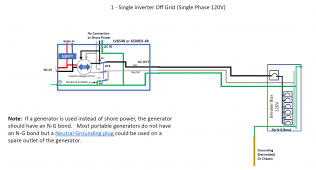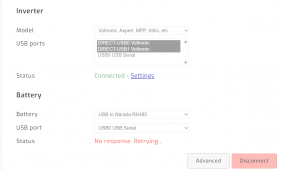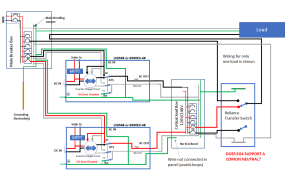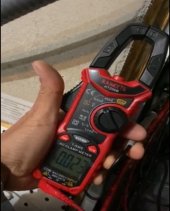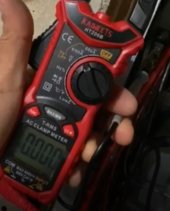I'm exploring adding a pair (or 4) 6500's to act as a whole home UPS, along with about 20 kW worth of PV strings as well.
But first a little background since I'm new here. I installed solar arrays on my property in back the fall of 2016 and have a Net Metering agreement with my local POCO. They credit me back 1:1 for every kWh I push back into the grid during daily peaks. So during the summer months, I build up a bank of kWh on my account that I then consume during the winter months. However, lately I have been consuming more than I use all year due to running crypto miners.
I have just shy of 60 kW worth of PV arrays currently. All the solar arrays are located around my shop building that is about 200 feet from the main house. That's where all my SMA inverters are located as seen here:
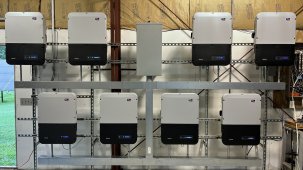
They are all connected to a 225A sub-panel, which is turn goes to a 400A junction box, that then runs up to the house where there's a 400A fused disconnect. Here's an an overview of my current layout:
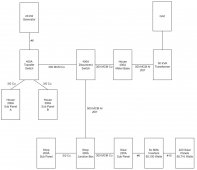
So lots of un-bonded subpanels. The only place where N and G are bonded, is in my 400A disconnect switch as shown below. The house 200A sub-panels are located immediately behind the transfer switch. You can see the wires going through the wall:

Next to the disconnect switch is a 400A automatic transfer switch which has a 20 kWh Kubota diesel generator for backup power when the grid is down:
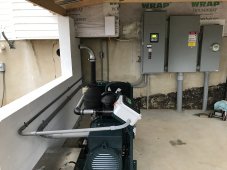
So what I would like to do, is to incorporate a pair of 6500's into the mix with a battery bank, to basically run the house on batteries and have the grid/existing solar system keep the batteries topped off.
Looking back 30 days, the peak consumption for the house feeder got close to around 8,000 watts on each "leg" as seen here on 8/7/22:

Looking at my overall usage over the last month, this is what I got: (green bars for the house)
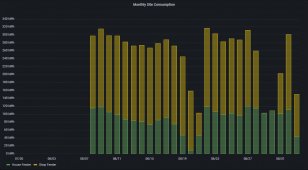
So around 100 kWh a day on average for the house.
And my grid tied solar production over the same period:
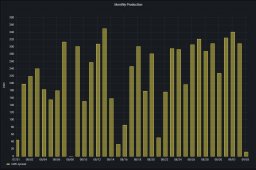
So adding an off-grid system to the house with around 20 kW capacity should get me close to zero net usage from the grid. The EG4's not being grid tied actually works out great for me since I have maxed out the 50 KVA transformer going to the grid. So I would not have been able to add more grid tied inverters even it I wanted to.
So now my questions:
1. Can the inverters and battery banks be located in my non-insulated "power room"? It does have windows on it now, but there is a large 10x7 or so opening to the elements. I live in central Virginia, so we do see frost in the winter and 90+ degree temps in the summer. If I'm able to eliminate the backup generator, I could completely enclose and insulate that room. I realize I can't charge LiFePO4 batteries below freezing, but the BMS would prevent that right? Plus, I'm sure I could some of those small heating pads to keep them at the proper temp.
2. Give my consumption shown above, would a pair of 6500's be able to handle my house? I have a 5 ton Trane XL20i dual stage A/C with some mini splits in other parts of the house. I also have servers running in the house 24/7 (maybe 1000 watts between them), as well as a pool pump (about 500 watts) and various smaller water pumps (fish pond and duck pond). Stove is fortunately gas, but dryer is electric. Also have well pump that I think is about 1hp. Fortunately, the heavy hitters (5hp air compressor, auto lift and welder) all down in the shop, so they won't be behind the 6500s. Given that I have peaks of 8000 watts, I unfortunately think I would need to go with 4 6500's...
3. I average about 4 power outages each year, lasting anywhere from a few hours, to several days. If I had a power outage of several days, I assume I could fire up a generator to top of the battery bank as needed? Or if I do install solar panels for the 6500's, those would serve the same purpose, except I might still need to run the generator at night and/or if it rains/snows or is very cloudy.
4. Is there a limit in the size of battery bank that can be connected to the 6500? The manual states charging capacity at 153A and recommended battery capacity as 250AH. Is that a hard limit, or could I go with a 1000AH bank with a pair of 6500s?
5. If I do a DIY bank of individual cells, is the 6500 compatible with, say the Overkill Solar 48V 16S 100A BMS?
6. Since I'll likely need to go with 4x 6500s, does this look like a reasonable diagram?
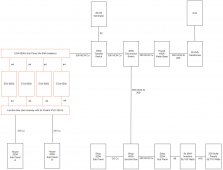
This way, during an extended power outage, the generator could kick on when the batteries needs to be topped off. I assume the 6500 has a closure relay to call for generator power?
Thanks!
But first a little background since I'm new here. I installed solar arrays on my property in back the fall of 2016 and have a Net Metering agreement with my local POCO. They credit me back 1:1 for every kWh I push back into the grid during daily peaks. So during the summer months, I build up a bank of kWh on my account that I then consume during the winter months. However, lately I have been consuming more than I use all year due to running crypto miners.
I have just shy of 60 kW worth of PV arrays currently. All the solar arrays are located around my shop building that is about 200 feet from the main house. That's where all my SMA inverters are located as seen here:

They are all connected to a 225A sub-panel, which is turn goes to a 400A junction box, that then runs up to the house where there's a 400A fused disconnect. Here's an an overview of my current layout:

So lots of un-bonded subpanels. The only place where N and G are bonded, is in my 400A disconnect switch as shown below. The house 200A sub-panels are located immediately behind the transfer switch. You can see the wires going through the wall:

Next to the disconnect switch is a 400A automatic transfer switch which has a 20 kWh Kubota diesel generator for backup power when the grid is down:

So what I would like to do, is to incorporate a pair of 6500's into the mix with a battery bank, to basically run the house on batteries and have the grid/existing solar system keep the batteries topped off.
Looking back 30 days, the peak consumption for the house feeder got close to around 8,000 watts on each "leg" as seen here on 8/7/22:

Looking at my overall usage over the last month, this is what I got: (green bars for the house)

So around 100 kWh a day on average for the house.
And my grid tied solar production over the same period:

So adding an off-grid system to the house with around 20 kW capacity should get me close to zero net usage from the grid. The EG4's not being grid tied actually works out great for me since I have maxed out the 50 KVA transformer going to the grid. So I would not have been able to add more grid tied inverters even it I wanted to.
So now my questions:
1. Can the inverters and battery banks be located in my non-insulated "power room"? It does have windows on it now, but there is a large 10x7 or so opening to the elements. I live in central Virginia, so we do see frost in the winter and 90+ degree temps in the summer. If I'm able to eliminate the backup generator, I could completely enclose and insulate that room. I realize I can't charge LiFePO4 batteries below freezing, but the BMS would prevent that right? Plus, I'm sure I could some of those small heating pads to keep them at the proper temp.
2. Give my consumption shown above, would a pair of 6500's be able to handle my house? I have a 5 ton Trane XL20i dual stage A/C with some mini splits in other parts of the house. I also have servers running in the house 24/7 (maybe 1000 watts between them), as well as a pool pump (about 500 watts) and various smaller water pumps (fish pond and duck pond). Stove is fortunately gas, but dryer is electric. Also have well pump that I think is about 1hp. Fortunately, the heavy hitters (5hp air compressor, auto lift and welder) all down in the shop, so they won't be behind the 6500s. Given that I have peaks of 8000 watts, I unfortunately think I would need to go with 4 6500's...
3. I average about 4 power outages each year, lasting anywhere from a few hours, to several days. If I had a power outage of several days, I assume I could fire up a generator to top of the battery bank as needed? Or if I do install solar panels for the 6500's, those would serve the same purpose, except I might still need to run the generator at night and/or if it rains/snows or is very cloudy.
4. Is there a limit in the size of battery bank that can be connected to the 6500? The manual states charging capacity at 153A and recommended battery capacity as 250AH. Is that a hard limit, or could I go with a 1000AH bank with a pair of 6500s?
5. If I do a DIY bank of individual cells, is the 6500 compatible with, say the Overkill Solar 48V 16S 100A BMS?
6. Since I'll likely need to go with 4x 6500s, does this look like a reasonable diagram?

This way, during an extended power outage, the generator could kick on when the batteries needs to be topped off. I assume the 6500 has a closure relay to call for generator power?
Thanks!
Last edited:



